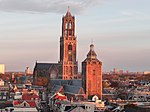Grand Hotel Karel V
1999 establishments in the NetherlandsBuildings and structures in Utrecht (city)Hospital buildings completed in 1823Hotels established in 1999Hotels in the Netherlands ... and 2 more
Pages containing links to subscription-only contentRijksmonuments in Utrecht (city)

The Grand Hotel Karel V is a hotel in Utrecht, Netherlands. It is located in the Duitse Huis complex of buildings, including part of the old monastery of the Bailiwick of Utrecht of the Teutonic Knights founded in 1348. Most of the rooms and suites are in a former military hospital, which dates from 1823 and has been carefully renovated, or in the modern Roman wing opened in 2008. The hotel contains a Roman-themed health center, conference rooms (Events Karel 5), a bar, Bistro Karel 5 and Restaurant Karel 5. It is set in extensive grounds.
Excerpt from the Wikipedia article Grand Hotel Karel V (License: CC BY-SA 3.0, Authors, Images).Grand Hotel Karel V
Geertebolwerk, Utrecht
Geographical coordinates (GPS) Address External links Nearby Places Show on map
Geographical coordinates (GPS)
| Latitude | Longitude |
|---|---|
| N 52.087872 ° | E 5.118389 ° |
Address
Grand Hotel Karel V
Geertebolwerk 1
3511 XA Utrecht (Utrecht)
Utrecht, Netherlands
Open on Google Maps








